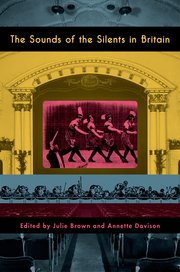The Sounds of the Silents in Britain
The Sounds of the Silents in Britain, edited by Julie Brown and Annette Davison. (Oxford University Press, 2013). 352 pages. ISBN: 978-0199797615 (hardback), £65; ISBN: 978-0199797547 (paperback), £22.50.
 About the reviewer: Michael Williams is a Senior Lecturer in Film at Southampton University. His latest book is Film Stardom, Myth and Classicism: The Rise of Hollywood’s Gods (Palgrave Macmillan). Some of his other publications include: British Silent Cinema and the Great War (Palgrave Macmillan, 2011); Ivor Novello: screen idol (British Film Institute, 2003); The idol body: stars, statuary and the classical epic. Film & History, 39, (2), 39-48. (doi:10.1353/flm.0.0120).
About the reviewer: Michael Williams is a Senior Lecturer in Film at Southampton University. His latest book is Film Stardom, Myth and Classicism: The Rise of Hollywood’s Gods (Palgrave Macmillan). Some of his other publications include: British Silent Cinema and the Great War (Palgrave Macmillan, 2011); Ivor Novello: screen idol (British Film Institute, 2003); The idol body: stars, statuary and the classical epic. Film & History, 39, (2), 39-48. (doi:10.1353/flm.0.0120).
The Sounds of The Silents in Britain is an important collection on a neglected field; exploring the diverse sonic dimensions of cinema as it developed across the era leading up to synchronised sound, presenting a richly evocative array of ephemeral cultural practices.
The past few years have seen a resurgence of interest in silent film. This is the product of much hard work by archivists, scholars and musicians in bringing cinema’s past back to vibrant and noisy life through festivals and publications, given added momentum by recent high-profile films such as The Artist and Hugo, and DVD and Blu-ray releases offering multiple commentary and music options. Indeed, the digital technologies that today pertain to construct a more immersive, attention-grabbing, cinema experience, finds strange resonances with the wonderful array of ephemeral cultural practices explored in this book, whether directing, controlling or enabling attention and social interaction in the cinema. Reading this book, one a gets a feeling for how rich and strange the cinema experience was for audiences in the early decades of cinema, and how full of sound in so many forms. The ‘silent’ auditoria thus evoked in the book’s essays emerge as Protean, immersive, and often very social, spaces that could experiment with new techniques and technologies, and respond to the needs of different audiences. If these essays evoke a tension between social and personal engagement, and different agencies competing for attention, whether the screen, or a lecturer, music or the audience themselves, these resonate as very modern concerns.
 While paying homage to pioneers in the field, such as Rick Altman, the new research presented here refines and often challenges conventional thinking about the development and practices in sound and music. Jon Burrows’ research, in particular, uses a close examination of cinema licensing records in London to indicate how few cinemas attempted to synchronise music to image before 1910, and that small orchestras, rather than lone pianos, were soon in much wider use than previously thought. As with Andrew Higson’s chapter, this research shows how it was rarely standard practice to closely follow the narrative of images on screen with music, which was even considered ‘bad policy.’ Audiences evidently experienced great variation between venues as to the kind of accompaniment they might experience, subject to divergent historical, and critical, preconceptions as to what might constitute ‘suitable music.’ The contributors show just how varied the role played by a lecturer, whose words could be in enabling a performative cinematic space, could be, whether or not they became the ‘terroristic mood setter,’ described in one marvellous description quoted by Judith Buchanan. Stephen Bottomore presents a fascinating case study of live sound pioneer, Eric Williams, who impressed audiences by his ability to lip-sync characters he played on screen; an elegant blurring of the line between screen persona and live appearance.
While paying homage to pioneers in the field, such as Rick Altman, the new research presented here refines and often challenges conventional thinking about the development and practices in sound and music. Jon Burrows’ research, in particular, uses a close examination of cinema licensing records in London to indicate how few cinemas attempted to synchronise music to image before 1910, and that small orchestras, rather than lone pianos, were soon in much wider use than previously thought. As with Andrew Higson’s chapter, this research shows how it was rarely standard practice to closely follow the narrative of images on screen with music, which was even considered ‘bad policy.’ Audiences evidently experienced great variation between venues as to the kind of accompaniment they might experience, subject to divergent historical, and critical, preconceptions as to what might constitute ‘suitable music.’ The contributors show just how varied the role played by a lecturer, whose words could be in enabling a performative cinematic space, could be, whether or not they became the ‘terroristic mood setter,’ described in one marvellous description quoted by Judith Buchanan. Stephen Bottomore presents a fascinating case study of live sound pioneer, Eric Williams, who impressed audiences by his ability to lip-sync characters he played on screen; an elegant blurring of the line between screen persona and live appearance.
 Learning on Screen
Learning on Screen